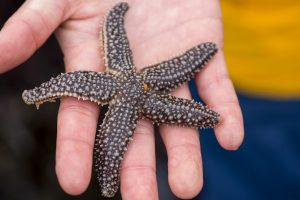Students’ Perspective on Exploring Marine Communities
 The ocean covers 71% of the Earth, and exploration of the deep ocean often unveils new and exciting species. Organisms are located in every possible type of marine environment encompassing extremes of salinity, pressure and light. Due to physiological constraints, however, many organisms are confined to narrow regions: for example, high primary production by algae is largely confined coastal zones due to nutrient limitations in the open ocean. Within biota-rich coastal communities, and especially the intertidal zone, chemical and physical forces result in ecological patterns that are common to much of the world’s coastlines. SBS students have extensive field based research to explore and understand such environmental gradient trends and the forces driving them.
The ocean covers 71% of the Earth, and exploration of the deep ocean often unveils new and exciting species. Organisms are located in every possible type of marine environment encompassing extremes of salinity, pressure and light. Due to physiological constraints, however, many organisms are confined to narrow regions: for example, high primary production by algae is largely confined coastal zones due to nutrient limitations in the open ocean. Within biota-rich coastal communities, and especially the intertidal zone, chemical and physical forces result in ecological patterns that are common to much of the world’s coastlines. SBS students have extensive field based research to explore and understand such environmental gradient trends and the forces driving them.
Exploring Species Distribution in Intertidal Zones
In most classroom-based ecology courses, students are introduced to the biotic and abiotic interactions that limit the distribution of intertidal species. Yet many of the interactions are often hard to conceptualize from pictures of the environment alone. New England’s — and especially Maine’s — extensive rocky intertidal shore is a haven for the investigation of factors limiting the distribution of marine organisms. The rocky intertidal coastline proximal to the Darling Marine Center (DMC) provides a plethora of locations and ecological conditions for exploration. Nearby Pemaquid Point, for example, provides two fundamentally different environmental conditions for comparison: wave exposed sites and protected sites. During the SBS “Marine Ecology” course, students explore distribution and abundance of intertidal organisms. Concepts such as grazing, predation, and interspecies competition are explored using field research experiments. Field data are used to quantify and explain the established distribution trends. Concepts build on each other over time, leading towards investigation of entire community structure. In addition, the focused SBS learning environment allows students to create their own primary literature during weekly reports. “There is no better way to understand an environment than through such personal, and personalized, investigation,” according to recent SBS students.
Understanding Succession, Competition & Climax Community Structure
A very common misconception of a pristine stable earth environment prior to the advent of industrial forces. The truth, however, is that community structures are constantly changing. Depending on the amount of disturbance, some communities may never make it to any sort of climax state and have a continuously changing community structure. Students find, through SBS field research, that communities with minimal disturbance will allow competitively dominant species and functional groups to thrive. If environmental gradients remain the constant then, following a disruption, resilient communities will return to climax state at some point: a climax community state refers to the composition of the community after succession has allowed the competitively dominant species to appear and stay. With the increasing impacts of humans, however, environmental gradients are being changed and communities suffering. Students can relate environmental gradients and community structure to other classes such as the “Estuarine Oceanography” course. In Estuarine Oceanography, students learn about environmental changes, such as eutrophication, caused by activities like increased nutrient input into rivers from cities and agriculture.
